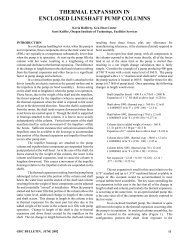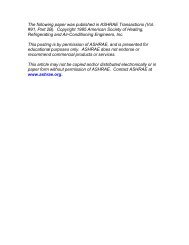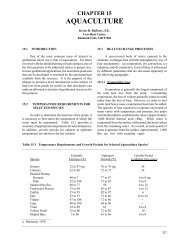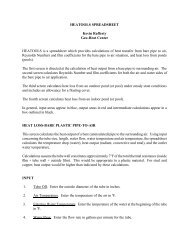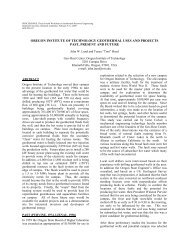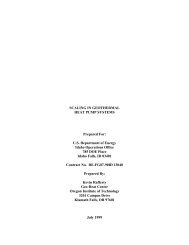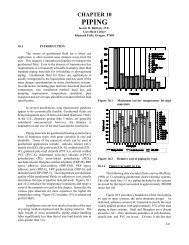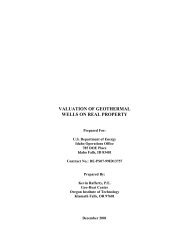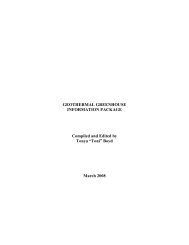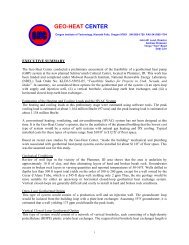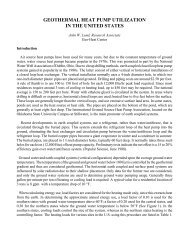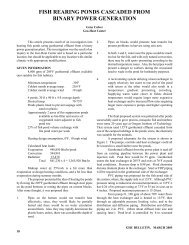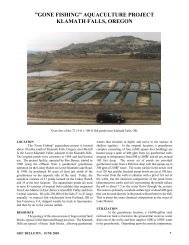Companion Study Guide on Short Course on Geothermal ... - OSTI
Companion Study Guide on Short Course on Geothermal ... - OSTI
Companion Study Guide on Short Course on Geothermal ... - OSTI
Create successful ePaper yourself
Turn your PDF publications into a flip-book with our unique Google optimized e-Paper software.
INTRODUCTION<br />
The ec<strong>on</strong>omic utilizati<strong>on</strong> of geothermal resources with temperatures less than 220 o F for<br />
purposes other than electric power generati<strong>on</strong> (direct utilizati<strong>on</strong>) requires creati<strong>on</strong> of systems with<br />
l<strong>on</strong>g plant life and minimum operati<strong>on</strong> and maintenance costs. Development of such systems requires<br />
careful corrosi<strong>on</strong> engineering if the most cost effective material selecti<strong>on</strong>s and design choices are to<br />
be made. This study guide presents guidelines for materials selecti<strong>on</strong> for low-temperature geothermal<br />
systems (120 - 200 o F), as well as guidance in materials design of heat pump systems for very-lowtemperature<br />
geothermal resources (less than 120 o F).<br />
This guideline is divided into five secti<strong>on</strong>s and an Appendix.<br />
1.0 Key Corrosive Species<br />
2.0 Modes of <strong>Geothermal</strong> Corrosi<strong>on</strong><br />
3.0 <strong>Geothermal</strong> Corrosivity Classificati<strong>on</strong> System<br />
4.0 Corrosi<strong>on</strong> Engineering of Low-Temperature Direct Utilizati<strong>on</strong> Systems<br />
5.0 <strong>Geothermal</strong> Heat Pumps<br />
Appendix Worksheets for Chemical and Scaling Properties of Low-Temperature<br />
<strong>Geothermal</strong> Waters<br />
These guidelines are based <strong>on</strong> Radian’s geothermal materials database, c<strong>on</strong>taining materials<br />
performance data from more than 20 low-temperature geothermal sites worldwide, as well as results<br />
of numerous comp<strong>on</strong>ent failure investigati<strong>on</strong>s c<strong>on</strong>ducted by Radian’s Materials Sciences Laboratory<br />
(MSL). Mush of this data is summarized in two DOE reports:<br />
Materials Selecti<strong>on</strong> <str<strong>on</strong>g>Guide</str<strong>on</strong>g>lines for <strong>Geothermal</strong> Energy Utilizati<strong>on</strong> Systems.<br />
and the Addendum to this report (the first two citati<strong>on</strong>s in the list of references).<br />
Unless otherwise indicated, the informati<strong>on</strong> herein is taken from these two documents.<br />
1.0 KEY CORROSIVE SPECIES<br />
<strong>Geothermal</strong> fluids comm<strong>on</strong>ly c<strong>on</strong>tain seven key chemical species that produce a significant<br />
corrosive effect. The key species are:<br />
• Oxygen (generally from aerati<strong>on</strong>)<br />
• Hydrogen i<strong>on</strong> (pH)<br />
• Chloride i<strong>on</strong><br />
• Sulfide species<br />
• Carb<strong>on</strong> dioxide species<br />
• Amm<strong>on</strong>ia species<br />
• Sulfate i<strong>on</strong>



